200 Search Results for video assessment
September 20, 2017
by Carole Zangari -
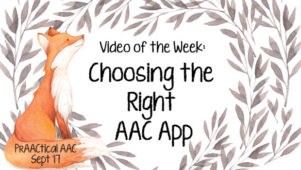
We’ve posted many times on the topic of AAC assessment and selecting the right AAC tools through the feature match process. In today’s featured video, Justin Sims from the Louisiana AT Initiative shares his thoughts on selecting AAC apps. Many thanks to Justin and the wonderful team at LATI for making this available. Direct Link to Video: https://www.youtube.com/watch?v=8HrkCqOw9zg
January 11, 2017
by Carole Zangari -
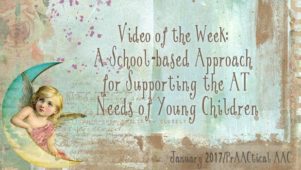
We’re excited by the growing number of professionals who support the AT needs of young children, and, like many of you, always appreciate learning more about the practices of agencies and school systems that have initiatives in this area. It takes a lot of courage to share your practices and approaches, and we respect those organizations willing to do so. In today’s video, we learn about the processes in place in Fairfax County, Virginia which serves approximately 25,000 special education students. Dr. Cheryl Temple and her colleagues Celeste Rodrigo and Malia Waller, explain their process for supporting young children with AT needs, including AAC, in early childhood and preschool classrooms. Many thanks to the Center on Technology and Disability for hosting this webinar and making the recording available. AT Assessments and Interventions: Tots Can Tech, Too You can access the handouts for this session from the CTD website here... [Read More...]
January 4, 2017
by Carole Zangari -
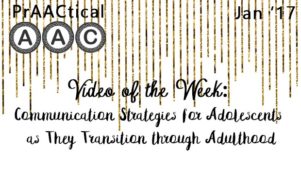
Across the world, many adolescents and young adults grew up with little or no access to appropriate AAC services. How can we support the communication needs of this group as they transition to adulthood? In today’s featured video, Pat Ourand has some ideas. Many thanks to her and to the Center on Technology and Disability for making this available. Direct link to video: https://www.youtube.com/watch?v=0o15ABNqmMg&list=PLRt8N3Siu_0hcGQnJI9ujwCwvNhjRn5IK&index=18
August 3, 2016
by Carole Zangari -
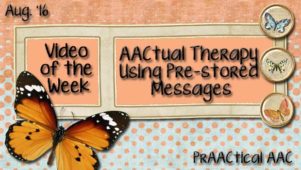
In the past few years, we’ve written a lot about the value of AAC systems that are rich in single core vocabulary words. Our position has always been, however, that many users of AAC will also benefit from fringe vocabulary words and selected prestored messages. You can read more about that here. To be sure, pre-stored messages, including phrases, sentences, and full questions, have their drawbacks. The main downside relates to the lack of flexibility they offer. Once programmed into a device, the communicator has to use them just the way they are. If he/she wants to say a variation of that message, they are out of luck. In the context of a robust system, however, this isn’t as problematic as it sounds. Individuals who have been provided with robust AAC systems can go to their single word vocabulary to be more precise if the pre-stored message doesn’t capture exactly... [Read More...]
June 1, 2016
by Carole Zangari -
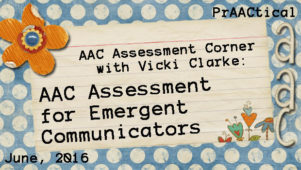
Today, we welcome back Vicki Clarke with more helpful information on conducting AAC assessments. If you work with individual who are at the early stages of communicative development, this post is for you! :::::::::::::::::::::::::::::::::::::::::::::::::::::::::: Some of my most favorite students are those who, at first, may not seem to notice me at all. Sometimes these students seem to exist in their own worlds. They don’t seem to respond in ways we would expect: looking, attending, listening, or gesturing. They may have a diagnosis of Autism, significant developmental delay, epilepsy, or any number of syndromes. I love these kids, and unfortunately, these are often the students who don’t get referred to me. Sometimes it takes years of working in a district before I get to see students with significant developmental delays. These children are typically served in classrooms for students considered to be severe/profound or multi-handicapped. Honestly, I usually get the... [Read More...]
May 25, 2016
by Carole Zangari -
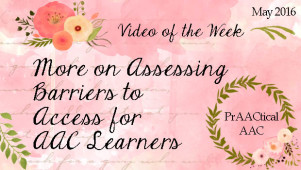
Today, we feature the second part of the presentation by Dr. Rae Sonnenmeier on assessing barriers to AAC. (You can see Part 1 here). In this video, she provides more in-depth information and prAACtical solution strategies. Many thanks to the Institute on Disability at the University of New Hampshire for making this available. Direct Link to Video – https://vimeo.com/86724224
May 18, 2016
by Carole Zangari -
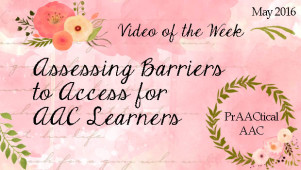
We’re continuing our journey of strengthening AAC assessment practices. In today’s featured video, we return to the Institute on Disability at the University of New Hampshire to consider additional ways to make our evaluation practices more meaningful. Many thanks to their AT team and Dr. Rae Sonnenmeier for this helpful information. Direct Link to Video – https://vimeo.com/80741615 Links to client videos referred to in the presentation Tyler: https://www.youtube.com/watch?v=WzqNPx1OVTU Holly: https://www.youtube.com/watch?v=woCsgnXwOyg
May 11, 2016
by Carole Zangari -
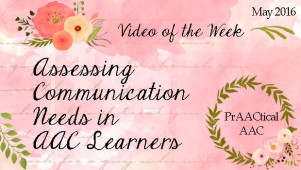
Looking to strengthen your AAC assessment practices? Over the next few weeks, we’ll be highlighting some videos that provide frameworks and prAACtical suggestions that may be helpful. In today’s video, Dr. Rae Sonnenmeier, of the Institute on Disability at the University of New Hampshire, discusses processes and strategies that make our AAC assessments more effective and meaningful. Direct Link to Video: https://vimeo.com/88019903 The Communication Success Screening Tool referred to in this video can be accessed here. Thanks to Tobii Dynavox for making that available.
May 5, 2016
by Carole Zangari -
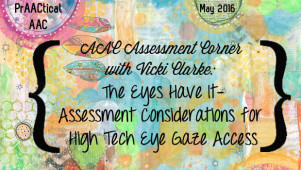
AAC assessment is an area that most professionals struggle with for one reason or another. I am so grateful to Vicki Clarke for returning to share her thoughts on the prAACticalities of conducting these evaluations. If you are looking for tips on assessing someone who needs high tech eye gaze AAC, this post is for you. For other posts authored by Vicki, click here. ::::::::::::::::::::::::::::::::::::::::::::::::::::::::::: The Eyes Have It: Assessment Considerations for High Tech Eye Gaze Access Eye gaze control for AAC device access is a hallmark technological achievement in the world of speech generating devices. For people with significant motor challenges we are no longer limited to scanning as our one choice for AAC access. AAC Specialists have been using light tech eye gaze boards and PVC pipe frames with these friends for years, but now we are able to offer voice output. Eye gaze is for a much... [Read More...]
July 6, 2015
by Carole Zangari -
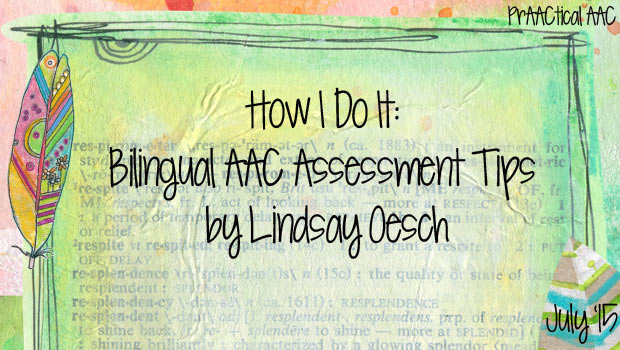
One of the things that I love most about where I live is the rich mix of cultural heritages and linguistic backgrounds in the clients we serve. It can be challenging to do a good assessment, though. Today, we hear from Lindsay Oesch who shares her thoughts on AAC assessments with children from bilingual environments. Don’t miss clicking through to get the parent questionnaires and other resources she shares in her post. :::::::::::::::::::::::::::::::::::::::::::::: Beginning the AAC Assessment Process with Bilingual Children As a clinician in New York City, it is so exciting to be working with children ages 5-12 as a speech-language pathologist in one of the most culturally and linguistically dynamic places in the world. It has also remained a major challenge to assess and treat children with speech and language impairment/delay who speak more than one language, in order to accommodate their specific language needs. Assessment for a communication... [Read More...]









